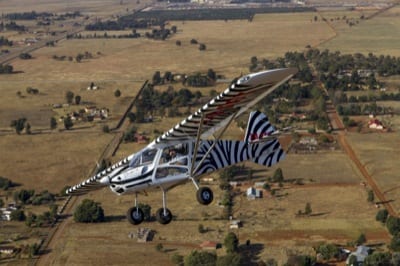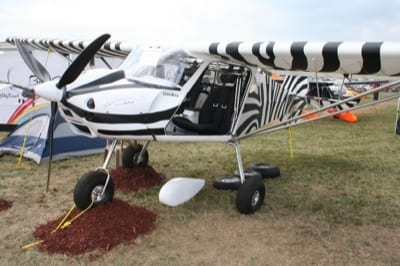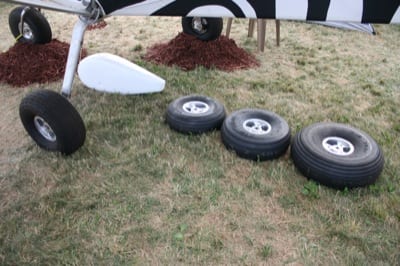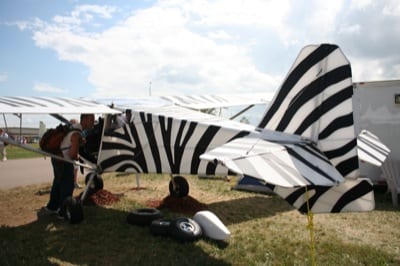If you want people to notice your aircraft, it helps if you have a unusual and eye-catching paint job. The folks from South Africa-based SkyReach certainly accomplished that goal with the black and white zebra design on the BushCat, a high-wing Light-Sport Aircraft that was the center of the company’s display at this summer’s AirVenture.
In the United States, AeroSport, based in Twin Lakes, Wis., is the distributor of the sporty, yet functional LSA.
 Both the South African and U.S. contingent were present in Oshkosh, ready to answer questions about the BushCat. One of the most asked was, “How did you get such an intricate paint design?”
Both the South African and U.S. contingent were present in Oshkosh, ready to answer questions about the BushCat. One of the most asked was, “How did you get such an intricate paint design?”
According to SkyReach spokesman Michael Gill, the distinctive black and white design was created from a photograph of a zebra.
“The image was projected onto the side of the aircraft and the outline of the stripes were traced,” he explained. “We used that to make the template. We wanted to promote our African heritage and you can’t go wrong with African wildlife.”
The BushCat is an evolutionary product of the Cheetah XLS. It is designed to be rugged enough for use in the African back country.
“The BushCat is primarily aluminum tube and rag construction, so it is extremely easy to maintain,” Gill said. “It is also put together in a modular fashion, so if you were to damage a part, you can unbolt the part that’s damaged, replace it with a new part, and fly away. That’s much appreciated in remote locations where a lack of parts can lead to expensive downtime.”
 Getting into the BushCat is easy. You back in and pull in your legs. The cockpit measures 47.5 inches across, but seems larger because of the numerous plexiglas windows. Wingspan is 31.5 feet. Spinner to tail, it measures 18.6 feet.
Getting into the BushCat is easy. You back in and pull in your legs. The cockpit measures 47.5 inches across, but seems larger because of the numerous plexiglas windows. Wingspan is 31.5 feet. Spinner to tail, it measures 18.6 feet.
The useful load of the BushCat is 628 pounds. Behind the seats is room for baggage, up to 81 pounds of it.
The BushCat, available in kit form and ready to fly, can be delivered with either a tailwheel or nosewheel. There are also options for wheelpants.
Gill postulates, however, that most of pilots who want the airplane will want the airplane sans wheelpants for ease of operation in remote areas with unimproved runways.
“We also offer a variety of tire and wheel sizes,” he said. “The landing gear is spring aluminum. We have removed the strut undercarriage to make it more rugged.”
 The cockpit is outfitted with two throttle controls. Depending on the choice of engine, the BushCat has a climb rate of 700 feet per minute to 1,200 fpm. Engine choices include the 65-hp Rotax 582, the 80-hp Rotax 912, and the 100-hp 912 ULS.
The cockpit is outfitted with two throttle controls. Depending on the choice of engine, the BushCat has a climb rate of 700 feet per minute to 1,200 fpm. Engine choices include the 65-hp Rotax 582, the 80-hp Rotax 912, and the 100-hp 912 ULS.
Because of its sturdy construction, the load factor of the BushCat is +6 and -4 Gs, Gill noted.
Maximum crosswind component is 32 mph (27.8 knots). For comparison, the maximum demonstrated crosswind component of a Cessna 172 is 17 knots.
The airplane is designed to be a working airplane, said Gill, adding that the World Wildlife Fund is using BushCats to patrol the skies to catch rhino poachers.
According to Gill, the World Wildlife Fund had a very strict list of needs when they went looking for an aircraft.
“The World Wildlife Fund held a workshop because they were looking for an aircraft that they could use for these patrols,” he said. “They came up with a long list of things they wanted in an aircraft. By the end of the day they had found that most of the aircraft they had been considering didn’t meet their requirements, but the BushCat did.”
 In order to do the poaching patrols, the pilot must stay in the air for hours at a time without refueling. The BushCat does that with ease, said Gill, with relatively low operational cost.
In order to do the poaching patrols, the pilot must stay in the air for hours at a time without refueling. The BushCat does that with ease, said Gill, with relatively low operational cost.
“Endurance of the airplane is about seven and a half hours, which is more than my endurance in it, I’m sure,” said Gill, noting fuel capacity is 24.8 gallons. “It costs are about $30 per hour. That’s in United States currency, because it runs on automobile fuel.”
For more information: Aerosportplanes.com
